|
REVERSE ACTION OFFENSE
In 1959, Pete Newell was able to upset West Virginia and their great player
Jerry West with an offense in the NCAA Championship Game that was a hybrid of
the Triangle offense and the Shuffle offense. This offense would later be
run by Bob Knight at the United States Military Academy with great success in
part because of a point guard named Mike Krzyzewski. This offense is known
as the Reverse Action offense.
Advantages of the Reverse Action Offense
The Reverse Action can lend itself to post-ups and lay-ups thanks to the basic
movement. The parts of the offense from the Triangle offense will allow
the offense to enter the ball into the post for a post move and a
high-percentage shot. The parts of the offense that come from the Shuffle
offense will lead to lay-ups off of back screens.
With many offense like it, the Reverse Action offense has several counters that
will catch a defense if they try to take away certain aspects of the offense.
This can include sideline pick-and-roll plays and backdoors in the basic
movement. The guards can also take advantage with the handoffs by either
attacking the basket or shooting perimeter jump shots off of the handoff.
Finally, the Reverse Action offense is a great offense when a team has three
post players capable of posting up and handling the ball on the perimeter.
Post players in the offense need to be capable of making solid cuts off of back
screens, shooting perimeter jump shots, and posting up against the defense.
Disadvantages of the Reverse Action Offense
Because the Reverse Action offense is a patterned offense, the defense can
easily scout the offense and start taking away the basic movement in the
offense. If this happens, the players running the offense must be able to
run the counters successfully.
In addition, the players may become so narrowed on running the basic continuity
of the offense that the players may not realize the options available to them.
If this happens, mistakes can be made and turnovers will develop. It might
also result in ill-advised shots in the offense.
Also, the Reverse Action offense requires that the three post players be capable
of handling the ball on the perimeter, being capable of making the shuffle cut,
and posting up in the low post area. It is very difficult to put together
a team running this offense if you have players who are not capable of doing all
three things.
Basic Movement of the Reverse Action Offense
In starting the basic movement in the offense, we start the offense from a 2-1-2
look (Diagram 1). The ball-side forward will pop to the wing to catch the
pass from the point guard. When this happens, we will look to run a
dribble handoff and get the post up ready with the center and the opposite guard
at the point (Diagram 2).
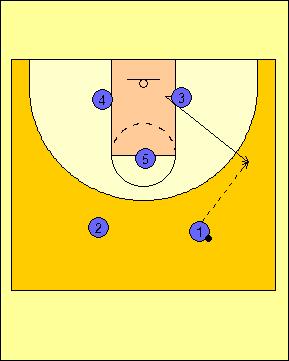
Diagram
1 |
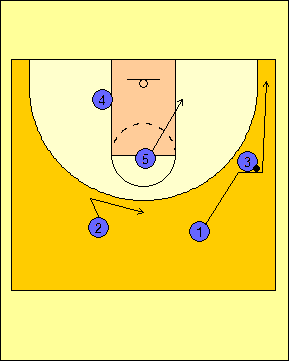
Diagram
2 |
Diagrams 3-8 illustrate the basic movement in the
Reverse Action offense when the ball is swung from one side of the
floor to the other. Whenever the ball is passed from the point
to the forward at the wing opposite the side of the ball's origin,
the handoff is set up with the passer and the receiver.
Meanwhile, the action on the help-side takes place with the low post
stepping out to set a back screen for the forward at the help-side
wing to get the action of the shuffle cut. The other guard
will cut along the three-point line from the corner to the point to
look for the basketball if the forward cannot enter the ball on the
shuffle cut.
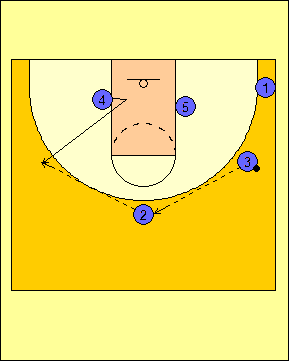
Diagram
3 |
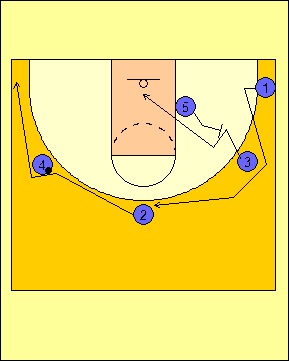
Diagram
4 |
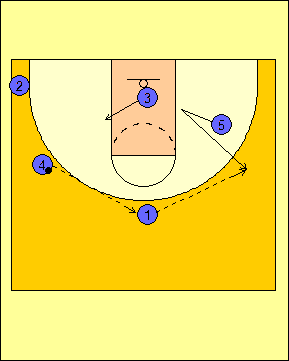
Diagram
5 |
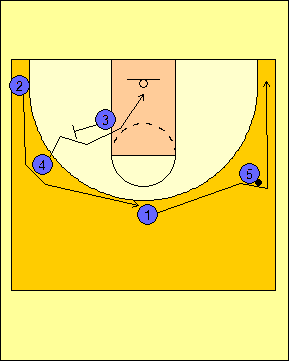
Diagram
6 |
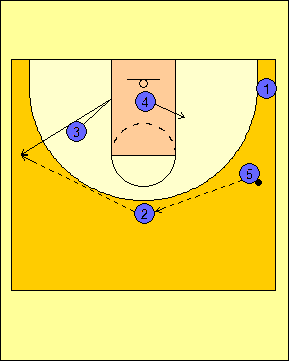
Diagram
7 |
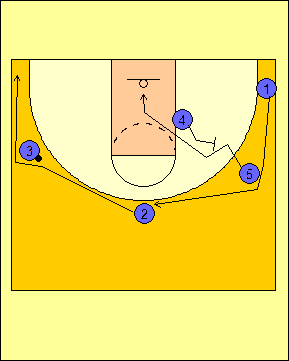
Diagram
8 |
Post Entries
Any time the ball is entered into the post, whether
it is from the wing or the corner, we have a set movement for our
players. In Diagram 9, the ball is entered with a pass to the
post. The forward at the wing and the guard in the corner will
bleed across to the other side. The post can hand off to the
guard or throw over the top to the forward to reverse the
basketball.
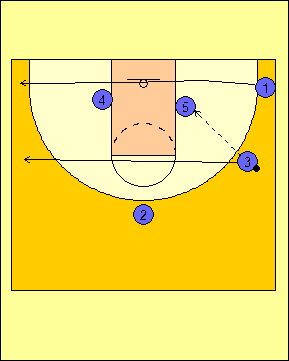
Diagram
9 |
Counters
There are times when the ball is passed to the
corner. When this happens, we have to have some options
available to us. In Diagram 10, the first look of an entry to
the post is achieved. The ball-side post will look to catch
the ball and hold his position for a count of two seconds.
Diagram 11 shows what happens when we are not able
to enter the ball to the post when the ball is passed to the corner.
The ball-side post will step out and set a back screen for the
forward at the wing. If the forward does not get the ball off
of the screen the ball-side post will set a ball screen for the
guard in the corner and the pick-and-roll will commence as drawn in
the diagram.
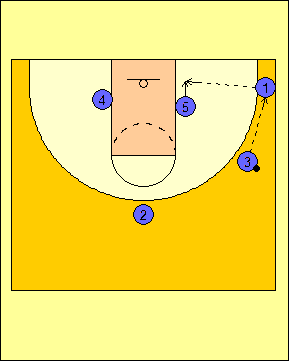
Diagram
10 |
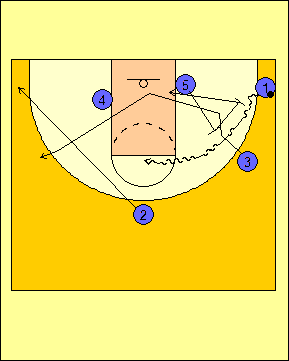
Diagram
11 |
Another counter that we must take into consideration
is when the ball is at the point and we are unable to reverse the
floor due to overplay. If this happens, the forward looking to
get open at the wing will cut backdoor (Diagram 12). He must
do whatever he can to get open.
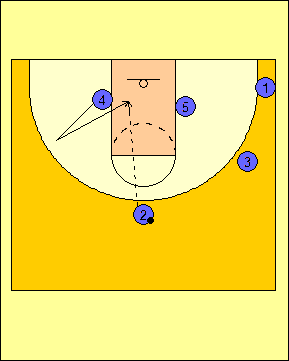
Diagram
12 |
Options on the Pass to the Wing
When we pass the basketball to the post player at
the wing, we will send the guard who makes the pass to go get the
ball back. If not, he goes to the corner. Off of this
pass, there are two options available. The first of these is
to use the post player at the wing as a ball screener and attack the
basket with the dribble (Diagrams 13 and 14).

Diagram
13 |
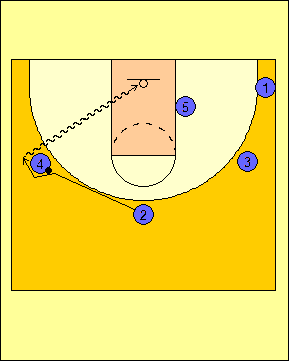
Diagram
14 |
The second of these is to use the post at the wing
as a ball screener, but to set up the jump shot (Diagrams 15 and
16). We teach our guards that they are to dribble drive
against a defense that tries to follow you and to shoot the jumper
when he goes under the screen.

Diagram
15 |
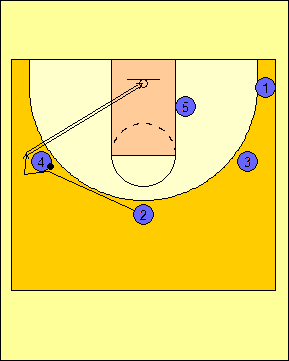
Diagram
16 |
Teaching the Reverse Action Offense
The first way that we teach this offense is with
Offensive Script with the five offensive players running the offensive
patterns. We can also use Offensive Script to teach the counters
in the offense. This works as a way to teach the offense with a
whole-part-whole approach.
There are two breakdown drills that can be done to work on the handoff between
the post at the wing and the guards and the post continuity. We will work
on the handoff with the guard passing to the forward at the wing and working on
the handoff. This would allow the guards to work on shooting and attacking
the basket off of the handoff.
We will also work on the continuity with the three post players. We will
position a coach at the point and work three-on-zero to start. From there,
we will add the defense and work with three defenders guarding the three post
players.
RETURN TO MEMBERSHIP AREA
© 2010-2017 Alan Peel Enterprises
|